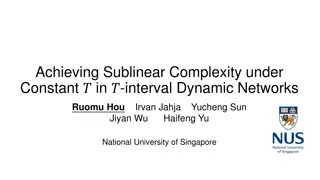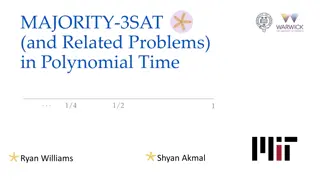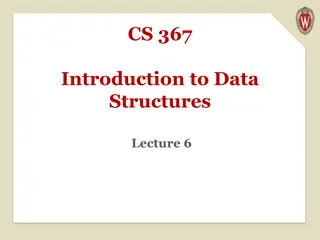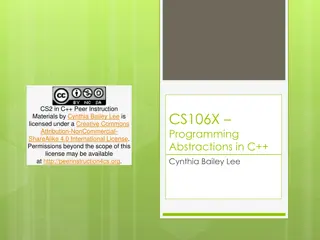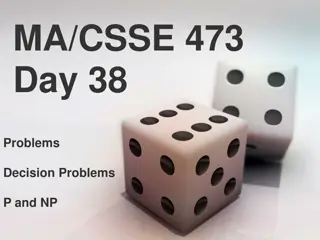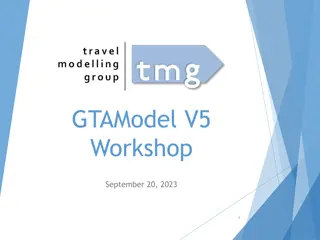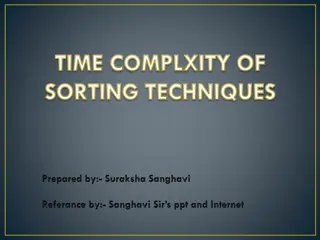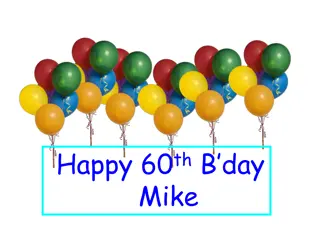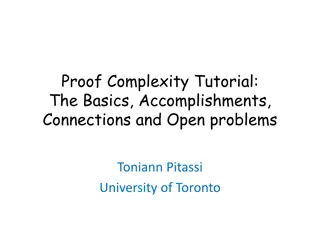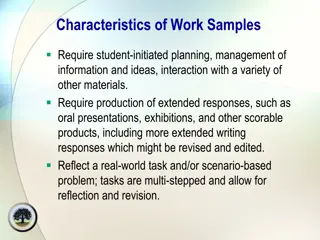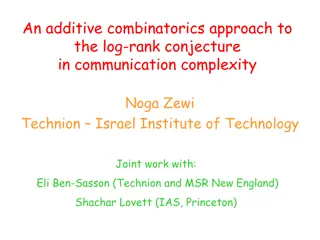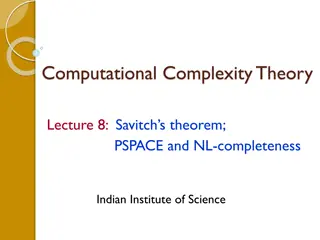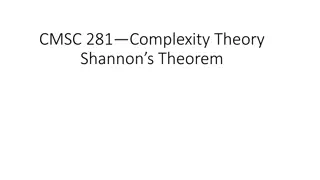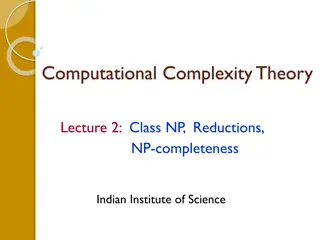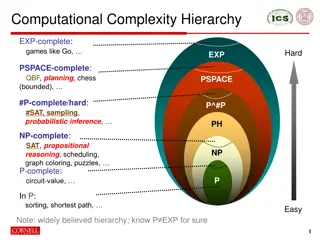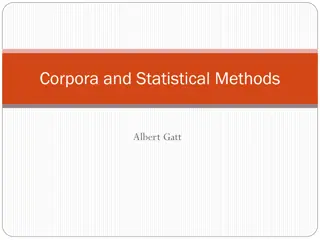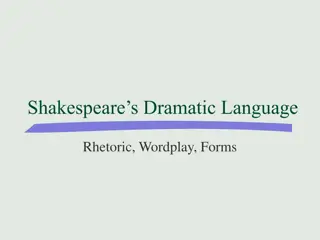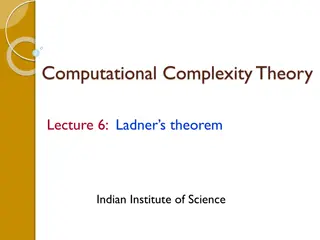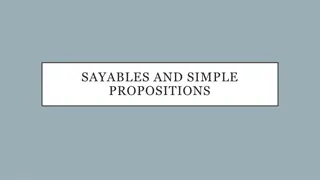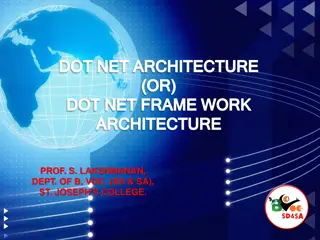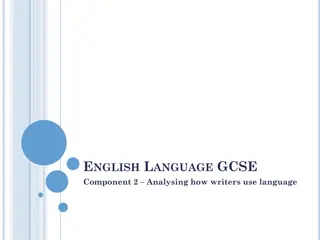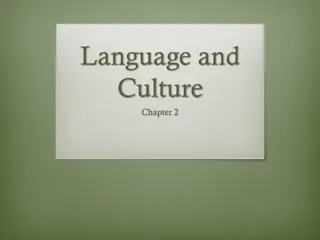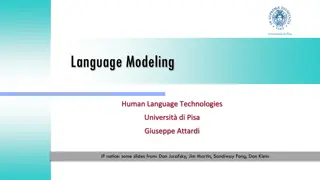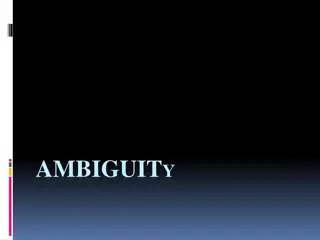Unraveling the Complexity of Language Understanding in AI
Much of intelligence is intertwined with language understanding, making it a focal point in AI. Speech recognition and natural language processing involve analysing spoken input, mapping phonetic units to words, capturing word roles, constructing semantic representations, and interpreting messages in context. Challenges include handling continuous speech, accents, dialects, and ambiguous sentences. Language evolves over time, posing continuous challenges to NLP systems.
Download Presentation

Please find below an Image/Link to download the presentation.
The content on the website is provided AS IS for your information and personal use only. It may not be sold, licensed, or shared on other websites without obtaining consent from the author. Download presentation by click this link. If you encounter any issues during the download, it is possible that the publisher has removed the file from their server.
E N D
Presentation Transcript
Understanding Language So much of intelligence seems to revolve around language understanding one of AI s primary pursuits has been speech recognition and natural language processing (NLU and NLG) SR/NL processing is not merely a matter of mapping words to meanings for SR, we have to analyze the spoken input, obtain auditory features, identify those features as phonetic units and map them to words and phrases for NL, we need to capture word roles (grammatical categories) and their meanings construct representations for the semantic meanings of phrases, individual sentences and groups of sentences interpret the meaning of the message within the context of other messages and the domain of discourse apply context for references apply worldly knowledge
SR Problems Continuous versus discrete speech if speech is spoken continuously, how do we find the borders between words? without borders, the search space becomes much larger sounds influence each other a particular phonetic unit sounds different when it is followed by one phonetic unit versus another versus silence, and also influenced by what comes after it People speak differently accents, dialects people s voices will change when excited/angry, bored, reading versus naturally speaking, etc there are over 1 million words in English, and many different ways to utter the same thing
NLU Problems Sentences can be vague but people will apply a variety of knowledge to disambiguate what is the weather like? It looks nice out. what does it refer to? the weather what does nice mean? in this context, we might assume warm and sunny The same statement could mean different things in different contexts where is the water? pure water in a chemistry lab, potable water if you are thirsty, and dirty water if you are a plumber looking for a leak Language changes over time so a NLP system may never be complete new words are added, words take on new meanings, new expressions are created (e.g., my bad , snap ) There are many ways to convey one meaning
Fun Headlines Hospitals are Sued by 7 Foot Doctors Astronaut Takes Blame for Gas in Spacecraft New Study of Obesity Looks for Larger Test Group Chef Throws His Heart into Helping Feed Needy Include your Children when Baking Cookies
Ways to Not Solve This Problem Simple machine translation we do not want to perform a one-to-one mapping of words in a sentence to components of a representation this approach was tried in the 1960s with language translation from Russian to English the spirit is willing but the flesh is weak the vodka is good but the meat is rotten out of sight out of mind blind idiot Use dictionary meanings we cannot derive a meaning by just combining the dictionary meanings of words together similar to the above, concentrating on individual word translation or meaning is not the same as full statement understanding
What Is Needed to Solve the Problem Since language is (so far) only used between humans, language use can take advantage of the large amounts of knowledge that any person might have thus, to solve NLU, we need access to a great deal and large variety of knowledge Language understanding includes recognizing many forms of patterns combining phonetic units into words identifying grammatical categories for words identifying proper meanings for words identifying references from previous messages Language use implies intention we have to also be able to identify the message s context and often, communication is intention based do you know what time it is? should not be answered with yes or no
SR/NLU Through Mapping
Speech Visualization Cepstral features represent the frequency of the frequencies Mel-frequency cepstral coefficients (MFCC) are the most common variety
Radio Rex A toy from 1922 A dog mounted on an iron base with an electromagnetic to counteract the force of a spring that would push Rex out of his house The electromagnetic was interrupted if an acoustic signal at 500 Hz was detected The sound e (/eh/) as found in Rex is at about 500 Hz So the dog comes when called
ARPA SR Research ARPA started an initiative in 1970 for SR research Multispeaker, continuous speech of a decent sized vocabulary (1000 words) and grammar 4 systems constructed HEARSAY (CMU) symbolic/rule-based using a blackboard/distributed architecture HARPY (CMU) giant lattice and beam search HWIM (BBN) HMM approach SRI and SDC never completed
Hearsay-II The original system implemented between 1971 and 1973 Hearsay-II was an improved version implemented between 1973 and 1976 Hearsay-II s grammar was simplified as a 1011x1011 binary matrix to indicate which words could follow which words Hearsay is more noted for pioneering the blackboard architecture And agent-based reasoning Hearsay spent a lot of time dealing with scheduling agents (KSs)
HARPY Unfolded a giant lattice of all possible utterances given the words and vocabulary Performed a beam search through this lattice matching expectations of a node with the acoustic signal for a match
ARPA and Beyond Results of the 4 systems shown below System Words Speakers Sentences Error Rate Harpy 1011 3 male, 2 female 184 5% Hearsay II 1011 1 male 22 9%, 26% HWIM 1097 3 male 124 56% SRI/SDC 1000 1 male 54 76% AT&T carried on from HWIM by implementing Byblos, a full HMM approach This was followed by Dragon which became the norm for SR systems
Bi-Grams and N-Grams Models the grammar by providing transition probabilities of going from one phonetic unit to another Bi-grams require about 292 different combinations, tri-grams about 293 combinations Here is a bi-gram (partial) model for English letters in a word NOTE: this is not the same as what we need in SR since these are letters, not phonetic units
HMMs and Codebooks The HMM is essentially a network that provides all transitions from phonetic unit to phonetic unit available in English Or the scaled down version that is dictated by the vocabulary and grammar Emission probabilities are based on how closely the expectation is from a given node in the HMM to a codebook The codebook is a listing of 256 different possible groupings of discretized values from the speech signal do a closest match search
Restricted Domains NLU has succeeded within restricted domains LUNAR a front end to a database on lunar rocks SABRE reservation system (uses a speech recognition front end and a database backend) used by American Airlines for instance to automate airline reservation and assistance over the phone SHRDLU a blocks world system that permitted NLU input for commands and questions what is sitting on the red block? what shapes is the blue block on the table? place the green pyramid on the red brick is there a red brick? pick it up By restricting the domain, it reduces the lexicon of words the target representation (in the above cases, the input can be reduced to DB queries or blocks world commands)
Morphology In many languages, we can gain knowledge about a word by looking at the prefix and suffix attached to the root, for instance in English: an s usually indicates plural, which means the word is a noun adding -ed makes a verb past tense, so words ending in ed are often verbs we add -ing to verbs we add de-, non-, im-, or in- to words Although morphology by itself is insufficient, we can use morphology along with syntactic analysis and semantic analysis to provide additional clues to the grammatical category and meaning of a word
Syntactic Analysis Given a sentence, our first task is to determine the grammatical roles of each word of the sentence alternatively, we want to identify if the sentence is syntactically correct or incorrect The process is one of parsing the sentence and breaking the components into categories and subcategories e.g., the big red ball is a noun phrase, the is an article, big and red are adjectives, ball is a noun And then generating a parse tree that reflect the parse Syntactic parsing is computationally complex because words can take on multiple roles we generally tackle this problem in a bottom-up manner (start with the words) but an alterative is top-down where we start with the grammar and use it to generate the sentence both forms will result in our parse tree
A parse tree for a simple sentence is shown to the left notice how the NP category can be in multiple places similarly, a NP or a VP might contain a PP, which itself will contain a NP Our parsing algorithm must accommodate this by recursion Parse Tree Example
Parsing by Dynamic Programming This is also known as chart parsing we start with our grammar, a series of rules which map grammatical categories into more specific things (more categories or actual words) S NP VP | VP | aux V NP VP we select a rule to apply and as we work through it, we keep track of where we are with a dot (initial, middle, end/complete) the chart is a data structure, a simple table that is filled in as processing occurs, using dynamic programming the chart parsing algorithm consists of three parts: prediction: select a rule whose LHS matches the current state, this triggers a new row in the chart scan: the rule and match to the sentence to see if we are using an appropriate rule complete: once we reach the end of a rule, we complete the given row and return recursively
Parsing by TNs A transition network is a simple finite state automata a network whose nodes represent states and whose edges are grammatical classifications A recursive transition network is the same, but can be recursive we need the RTN for parsing (instead of just a TN) because of the recursive nature of natural languages Given a grammar, we can automatically generate an RTN by just unfolding rules that have the same LHS non- terminal into a single graph (see the next slide) We use the RTN by starting with a sentence and following the edge that matches the grammatical role of the current word in our parse we have a successful parse if we reach a state that is a terminating state since we traverse the RTN recursively, if we get stuck in a deadend, we have to backtrack and try another route
Example Grammar and RTN S NP VP S NP Aux VP NP NP1 Adv | Adv NP1 NP1 Det N | Det Adj N | Pron | That S N Noun | Noun Rrel etc
Parsing Output We conceptually think of the result of syntactic parsing as a parse tree see below for the parse tree of John hit the ball The tree shows the decomposition of S into constituents and those constituents into further constituents until we reach the leafs (words) the actual output of a parser though is a nested chain of constituents and words, generated from the recursive descent through the chart parsing or RTN [S [NP [VP (N John)] [V hit] [NP (Det the) (N ball)] ] ] ]
Ambiguity Natural languages are ambiguous because words can take on multiple grammatical roles a LHS non-terminal can be unfolded into multiple RHS rules, for example S NP VP | NP VP NP Det N | Det N PP VP V NP | V NP PP is the PP below attached to the VP (did Susan see a boy who had a telescope?) or the NP (did Susan see the boy by looking through the telescope?)
Augmented Transition Networks An RTN can be easily generated from a grammar and then parsing is a matter of following the RTN and having a stack (for recursion) the parser generates the labels used as grammatical constituents as it traverses the RTN we can augment each of the RTN links to have code that does more than just annotates constituents, we can provide functions that will translate words into representations, or supply additional information is the NP plural? what is the verb s tense? what might a reference refer to? This is an ATN, which makes the transition to semantic analysis somewhat easier
ATN Dictionary Entries Each word is tagged by the ATN to include its part of speech (lowest level constituent) along with other information, perhaps obtained through morphological analysis
Semantic Analysis Now that we have parsed the sentence, how do we proscribe a meaning to the sentence? the first step is to determine the meaning of each word and then attempt to combine the word meanings (word sense disambiguation) this is easy if our target representation is a command if the NLU system is the front end to a DB Which rocks were retrieved on June 21, 1969? translate into SQL if NLU is the front end to an OS shell Print the newest textfile to printer1 translate into an OS command, e.g., lp p printer1 filename where filename is the name of the newest file in the current directory
Continued In general, how do we attribute meaning? what form of representation should the sentence be stored in? how do we disambiguate when words have multiple meanings? how do we handle references to previous sentences? what if the sentence should not be taken literally? Without the domain/problem, we have to come up with a general strategy As we ve seen, there is no single general representation for AI should we use CDs, conceptual graphs, semantic networks, frames? We will explore some ideas in the next few slides
Semantic Grammars In a restricted domain and restricted grammar, we might combine the syntactic parsing with words in the lexicon this allows us not only find the grammatical roles of the words but also their meanings the RHS of our rules could be the target representations rather than an intermediate representation like a parse S I want to ACTION OBJECT | ACTION OBJECT | please ACTION OBJECT ACTION print | save | print lp OBJECT filename | programname | filename get_lexical_name( ) This approach is not useful in a general NLU case
Semantic Markers One way to disambiguate word meanings is to define each word with semantic markers and then use other words in the sentence to determine which marker makes the most sense Example: I will meet you at the diamond diamond can be an abstract object (the geometric shape) a physical object (a gem stone, usually small) a location (a baseball diamond) here, we will probably infer location because of the sentence says meet you at you could not meet at a shape, and while you might meet at a gemstone, it is an odd way of saying it What about the word tank?
Case Grammars Rather than tying the semantics to the grammar as with the semantic grammar, or with the nouns of the sentence as with semantic markers we instead supply every verb with the types of attributes we associate with that verb for instance, does this verb have an agent? an object? an instrument? to open: [Object (Instrument) (Agent)] we should know what was opened (a door, a jar, a window, a bank vault) and possibly how it was opened (with a door knob, with a stick of dynamite) and possibly who opened it (the bank robber, the wind, etc) semantic analysis becomes a problem of filling in the blanks finding which word(s) in the sentence should be filled into Object or Instrument or Agent
Case Grammar Roles Agent instigator of the action Instrument cause of the event or object used in the event (typically inanimate) Dative entity affected by the action (typically animate) Factitive object or being resulting from the event Locative place of the event Source place from which something moves Goal place to which something moves Beneficiary being on whose behalf the event occurred (typically animate) Time time the event occurred Object entity acted upon or that is changed To kill: [agent instrument (object) (dative) {locative time}] To run: [agent (locative) (time) (source) (goal)] To want: [agent object (beneficiary)]
Example: Storing case grammars using conceptual graphs Here, we have the grammars for like and bite
Combining the conceptual graphs of sentences
Discourse Processing Because a sentence is not a stand-alone entity, to fully understand a statement, we must unite it with previous statements anaphoric references Bill went to the movie. He thought it was good. parts of objects Bill bought a new book. The last page was missing. parts of an action Bill went to New York on a business trip. He left on an early morning flight. causal chains There was a snow storm yesterday. The schools were closed today illocutionary force It sure is cold in here.
Handling References How do we track references? consider the following paragraph: Bill went to the clothing store. A sales clerk asked him if he could help. Bill said that he needed a blue shirt to go with his blue hair. The clerk looked in the back and found one for him. Bill thanked him for his help. in the second sentence, we find him and he , do they refer to the same person? in the third sentence, we have he and his , do they refer to the sales clerk, Bill or both? in the fourth sentence, one and him refer back to the previous sentence, but him could refer back to the first sentence as well the final sentence as him and his Whew, lots of work, we get the references easily but how do we automate the task? is it simply a matter of using a stack and looking back at the most recent noun?
Pragmatics Aside from discourse, to fully understand NL statements, we need to bring in worldly knowledge it sure is cold in here this is not a statement, it is a polite request to turn the heat up do you know what time it is is not a yes/no question Other forms of statements requiring pragmatics speech acts the statement itself is the action, as in you are under arrest understanding and modeling beliefs a statement may be made because someone has a false belief, so the listener must adjust from analyzing the sentence to analyzing the sentence within a certain context conversational postulates adding such factors as politeness, appropriateness, political correctness to our speech idioms often what we say is based on colloquialisms and slang my bad shouldn t be interpreted literally
Stochastic Approaches Most NLU was solved through symbolic approaches parsing (chart or RTN) semantic analysis using one of the approaches described earlier (probably no attempt was made to implement discourse or pragmatic understanding) But some of the tasks can be solved perhaps more effectively using stochastic and probabilistic approaches we might use a na ve Bayesian classifier to perform word sense disambiguation count how often the other words in the sentence are found when a given word is a noun versus when it is a verb, etc
Markov Model Approach We might use a HMM to perform syntactic parsing hidden states are the grammatical categories The observables are the words The HMM itself is merely a finite state automata of all of the possible sequences of grammatical categories in the language we can generate this from the grammar we can compute transition probabilities by simply counting how often in a set of training sentences a given grammatical category follows another e.g., how often do we have det noun versus det adj noun we can similarly compute the observation probabilities by counting for our training sentences the number of times a given word acts as a noun versus a verb (or whatever other categories it can take on) Parsing uses the Viterbi algorithm to find the most likely path through the HMM given the input (observations)
Other Learning Methods for POS SVMs train an SVM for a given grammatical role, use a collection of SVMs and vote, resistant to overfitting unlike stochastic approaches NNs/Perceptrons require less training data than HMMs and are quickly computationally Nearest-neighbor on trained classifiers Fuzzy set taggers use fuzzy membership functions to for the POS for a given word and a series of rules to compute the most likely tags for the words Ontologies we can withdraw information from ontologies to provide clues (such as word origins or unusual uses of a word) useful when our knowledge is incomplete or some words are unknown (not in the dictionary/rules/HMM)
Probabilistic Grammars We use a rule-based grammar as before but we annotate to each rule its likelihood of usage We need training data to acquire the probabilities (likelihoods) for each rule The system selects the most likely parse This approach assumes independency of rules which is not true and so accuracy can suffer
Features for Word Sense Disambiguation To determine a word s sense, we look at the word s POS, the surrounding words POS and what those words are Statistical analysis can help tie a word to a meaning Pesticide immediately preceding plant indicates a processing/manufacturing plant but pesticide anywhere else in the sentence would primarily indicate a life form plant The word open on either side of plant (within a few words) is equally probable for either sense of the word plant the window size for comparison is usually the same sentence although it has been shown that context up to 10,000 words away could still impact another word! For pen , a trigram analysis might help, for instance in the pen would be the child s structure, with the pen would probably be the writing utensil
Application Areas MS Word spell checker/corrector, grammar checker, thesaurus WordNet Search engines (more generically, information retrieval including library searches) Database front ends Question-answering systems within restricted domains Automated documentation generation News categorization/summation Information extraction Machine translation for instance, web page translation Language composition assistants help non-native speakers with the language On-line dictionaries
Information Retrieval Originally, this was limited to queries for library references find all computer science textbooks that discuss abduction translated into a DB query and submitted to a library DB Today, it is found in search engines take an NLU input and use it to search for the referenced items Not only do we need to perform NLU, we also have to understand the context of the request and disambiguate what a word might mean do a Google search on abduction and see what you find simple keyword matching isn t good enough
Template Based Information Extraction Similar to case grammars, an approach to information retrieval is to provide templates to be extracted from given text (or web pages) specifically, once a page has been identified as being relevant to a topic, a summary of this text can be created by excerpting text into a template in the example on the next slide a web page has been identified as a job ad the job ad template is brought up and information is filled in by identifying such target information as employer , location city , skills required , etc identifying the right items for extraction is partially based on keyword matching and partially based on using the tags provided by previous syntactic and semantic parsing for instance, the verb hire will have an agent (contact person or employer) and object (hiree)




